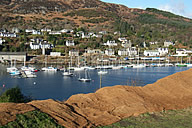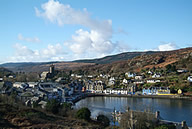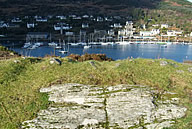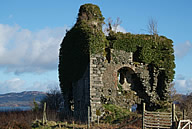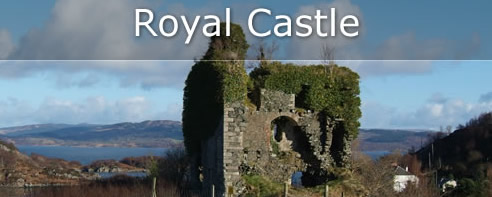
Tarbert Loch Fyne Royal Castle
Tarbert Castle
Few visitors to Tarbert fail to notice the Castle ruins on the hill above the village. No description of this ancient Burgh can be complete without mention of the castle and its connection with Robert the Bruce. Its outline is featured on almost all of Tarbert's holiday brochures. At one time ranking in importance with Scotland's best-known strongholds, the ruins are today mostly hidden by grass and ivy. Large parts of the history of Tarbert Castle are misted by the passage of time. This document tries to tell what is known of the part Tarbert and its Castle have played in Scottish history.
It is possible that Agricola and his Roman legionaries crossed the isthmas in AD 82 when they sailed down the firth and "placed forces in that part of Britain which fronts Ireland". Tarbert's strategic importance would be recognised even at that early date.
Later, after years of incursions by the Scots from Ireland, Kintyre and a large part of the seaboard of Argyll were seized by Loarn, Angus and Fergus Mor, the founders of the Scottish kingdom of Dalriada.
In early writings, "The Annals of Ulster" it is recorded that on two occasions what was believed to have been a fort, was burned by King Selbach and his son Dungal the Violent in the years 712 and 731 respectively. The phrase used in the annals is "Combustio Tairpirt Boetter".
Tarbert again appears in Histpry's headlines in 1098 when Magnus Barfod (Bare Leg) King of Norway had his ship drawn across the neck of land between West Loch Tarbert and Loch Fyne in order to claim Kintyre along with all the other islands on the West of Scotland. The "Treaty of Tarbert" agreed between Magnus and the Scottish King Edgar granted to Norway all the Western Isles round which a ship could sail. In 1263 King Haco of Norway still held sway over the Western Isles including Kintyre and Islay until the Norwegian hold was finally broken at the Battle of Largs in October of that year. Even as late as the seventeenth century, Kintyre was still regarded as one of the South Isles or "Sudreys".
In 1306 Robert the Bruce passed through Kintyre in his flight to Rathlin, and his appointment with a spider. Eight years later, Bruce secured his throne at the Battle of Bannockburn, and turned his attention to the chiefs of the Western Isles who were then acting as allies of England. On his way to confront them, Bruce chose the route across the isthmus of Tarbert. According to John Barbour (poet and historian of the 14th century) a track of logs was laid over the mile wide neck of land. The galleys were dragged over this primitive ship railway with sails set to take advantage of a favourable wind.
While Bruce's fleet was being hauled across the track one of his ships is said to have fallen over. One point on the route has the gaelic name "Lagluinge" which means "hollow of the ship".
Realising the importance of the isthmus and the necessity to defend it, Bruce set work in hand in 1325 to repair and extend an existing castle, standing on the hill above Tarbert harbour. The origin of this building has not been ascertained but may well have been a successor to the early fort burnt by Selbach and Dungal.
Architects David McGibbon and Thomas Ross wrote a detailed description of the castle as they found it, in 1887 and suggested its probable extent in earlier years. The building which Bruce found at Tarbert was "one of the Royal fortresses which Edward I caused to be handed over to Baliol, in 1292". They believed the castle at this stage to be a square enclosure, measuring about 8 feet thick, with an inner wall of similar thickness and a space between them of 18 to 20 feet. The castle rooms would have been contained within this space. The central area or courtyard has several large natural rocks projecting through the ground. In one corner of this courtyard there appears to have been a walled area of about 20 feet square which may have contained a well or reservoir for water. It was to these foundations that Bruce's repairs and additions were made. From the available documentation of this work the castle would seem to have been largely rebuilt.
The extension to the original castle was a large courtyard area to the east, measuring about 300 by 240 feet, bounded by a perimeter wall. On the east side facing the sea, two drum towers are incorporated in the wall. These may have been added at a later date Within this larger courtyard the new works included a Hall, built on piers, and a dwelling house. Other works, were the building of a chapel, a new kitchen, a wine house, bake house, goldsmiths house, malt house, brew house with a new vat, a mill with mill pond and lade, a moat and a lime kiln.
Much information is contained in an accounting for the work, submitted in 1326 by the then Constable for Tarbert, John de Lany. This is the oldest of the Scottish exchequer rolls stillexisting and is believed to provide "the earliest description of domestic architecture and modes or rural life in Scotland". The accounts submitted by de Lany give interesting details of the costs involved in the reconstruction. The principal contracter for the mason work was paid £282. 15s 0d. plus a bonus of £5. 6s 8d. "because in the King's absence he had built the walls wider than agreed on". The roofing of the houses in the castle occupied two roofers for forty days, and for this large undertaking they were paid 13 shillings and 4 pence. In today's decimal coinage this would be about 5 pence per week for each man.
Of the skilled tradesmen:
Neil the Smith was paid 4 pence per day; Neil the Plumber was paid 3 and 1/2 pence per day; John the Carpenter was paid 2 and 1/2 pence per day.
Sir Maurice the Chaplain by comparison was only paid at the rate of £2.00 for the half year - just over 1 new penny per day.
The king appears to have given personal attention to the progress of the work. He visited in 1325 with several of his lords, and stayed for some time. The accounts show that 'litter' was provided for chambers of Lamberton the Lord Bishop of St Andrews and Sir James, Lord of Douglas.
A fort at "Wester Tarbert" was built at this time. Payments were made towards the cost of wood for its construction and making of a road from the one Tarbert to the other. The location of this fort has lain unrecognised for several hundred years. However a site has recently been found which shows traces of stone foundations. A fort at this spot (near to the Kilberry Road junction with Campbeltown Road) would have affectively controlled access to the isthmus from the West Loch and would also have been in direct line of sight with the main castle at East Tarbert.
It is not clear how often Bruce visited his castle but entires in the accounts would suggest that he again stayed here in 1329, the year of his death. Wine and salt were bought "by the King at Tarbert" and for the king's entertainment a court jester "Patrick the fool" was brought from England.
The castle which had now been built, must have dominated the scene, standing high over the township which would lie below at the edge of the bay. The village of Tarbert is referred to as a Royal Burgh in several old documents. The earliest reference is in the Exchequer Roll for 1328 where a charge of seven shillings and eight pence is recorded for "making a coket for the Burgh of Tarbert". This was to be used in connection with a custom levy on goods exported through the port of Tarbert. At what date prior to this, Tarbert was proclaimed a burgh is open to conjecture. According to Bell's "Law of Scotland" Royal Burghs were normally found beside Royal Castles and Tarbert's Castle was classed as such as early as 1292. In any event Tarbert may be considered to be the oldest Royal Burgh in Argyll.
Several tenants occupied the castle during the ensuing years til 1494 in which year James IV resided at Tarbert on two occasions. During his first visit in April of that year he repaired the fort built by Bruce. It is probable that the keep or tower with its 'dungeon' was built at this time. The 'dungeon' is still relatively intact, but of the three upper floors only two walls remain standing. Facilities were established for his shipping, to transport artillery and a stock of gunpowder. On his second visit, parliament was summoned to meet at Tarbert on July 5, 1494 for the purpose of deciding ways of pacifying the still turbulent areas of Kintyre and the Islands. Local tradition suggests that the "Parliamentary sitting" was held in the Sheriff Court House, which is believed to have stood on the site now occupied by the Free Church. This stands at the east end of Back Street, reputed to be one of the earliest paved streets in Scotland.The cobbled surface only gave way to more modern materials in the 1950s when the old cottages were replaced by the Church Terrace housing scheme. A large stone which stood at the doorway of one of the cottages in the street was thought to have been used as a mounting step by horsemen for hundreds of years. Since the cottages were removed this stine is no longer in evidence.
King James again visited in March 1498 and April 1499. During this last visit the chief of the Clan Campbell was vested with extensive powers in the area, and a few months later was appointed "Keeper of the Castle of Tarbert", a title which is still borne today by the present Duke of Argyll.
About 1481 the Burgh of Tarbert had become the seat of a sheriff and an extensive shire. It covered the district of Kintyre, Knapdale and the islands of Gigha, Islay, Jura, Scarba, Colonsey and Mull. The shire of Tarbert returned its member to the Scottish parlaiment until its amalgamation with the shire of Argyll in 1633. For many years Tarbert and its castle were at the centre of the struggle between the MacDonalds and the Campbells for control of the surrounding districts.
In the early years of the sixteenth century a buccaneer of the West Coast (Alan-nan-Sop), an illegitimate son of Lachlan Catanach McLean, was given possession of Tarbert Castle by Alan MacDonald of Islay, who, it is assumed had forcibly acquired it from his hereditary foes, the Campbells. Alan-nan-Sop used the castle as a base. His plundering operations took him to Cowal, Loch Lomond, Bute and the Lowlands. With his ships he is reputed to have made forays even to Ireland. Alan lived to an old age and died about 1555.
By 1652 Tarbert Castle had passed into the hands of Round-heads, who are said to have strengthened it by constructing bastions and outworks. It was repossessed, at least for a time, by a body of Tarbert men, while the garrison were out gathering nuts. The villagers took the opportunity to appropriate quantities of gunpowder, cheese, and biscuits which they put to their own uses.
In 1865 Archibald Earl of Argyll took command of the Scottish expedition to be led against the army of James VII of Scotland and II of England. The various forces were summoned to Tarbert. By the May 27 1,800 men and horses had gathered there. The expedition was ill-fated, the Earl being taken prisoner and conveyed to Edinburgh where he was beheaded. The loss of land and titles which the Argyll family suffered as a result was temporary. By 1689 the Campell family had regained their former status.
In 1705 an Act of Scottish Parliament was passed in favour of Archibald McAlister instituting "four yearly fairs and a weekly mercat at the town of East Tarbet". Tarbert fair day (last Thursday in July) is still a highlight in the local calender and originated with this Act.
The McAlister family of Tarbert now tenanted the castle under charter from the Campbells. However a new mansion built at Barmore, became the McAlister residence, and Tarbert Castle fell into disrepair.
This matter was the subject of a unique lawsuit in 1762 when an action was raised against the last McAlister laird. The charter which granted the castle to the McAlisters, stipulated that the vassal should provide, "a boat of six oars in time of peace and war - and to preserve and maintain the said Castle of Tarbert, wind and watertight in all time coming". Despite this attempt by the superiors, the Argyll family, to ensure that Tarbert Castle should remain in a habitable state, repairs were not carried out. The fortunes of the McAlister family were on the wane, and their lands were sold off.
Today the castle remains are still in evidence on the hill above the harbour. Of Bruce's Castle and its perimeter wall only the grass covered outlines can be seen, while two walls of the keep built by James IV still stand to their original height. It appears to have lain thus for over two hundred years, as we see from the comments of travellers who visited Tarbert in days gone by.
Thomas Pennant in 1772 recorded his arrival in Tarbert thus, "with difficulty get through a strait of about a hundred yards wide, with sunk rocks on boths sides, into the safe and pretty harbour of the Eastern Loch Tarbert. The scenery is picturesque - at the bottom extends a small village; on the Cantyre side is a square tower, with vestiges of other remains."
The Rev Andrew Campbell in the Statistical Account of Scotland 1791-1799 says that the entrance to Kintyre was formerly defended by a chain of forts, one at each end of the isthmus at Tarbert, and one in the centre. The principal of them, the Castle at Tarbert, was then a "fine old ruin". He also records the general belief that the Castle was supplied with water by "a submarine passage in pipes across the harbour". (Even today there is a traditional belief in the existence of a "secret pasage" used as a means of escape from the castle, which led across the harbour).
In 1827 Lord Teighnmouth writes "the overhanging keep of its ruined castle, the village and the innumerable fishing boats choking up every nook and crevice form a scene singularly picturesque".
Ten years later in 1837 Lord Cockburn on his circuit journeys says "But Tarbert! East Tarbert! How it is that I have never heard of that curious little bay? - there it lay, calm and silvery - a curve of about twenty or thirty small houses drawn round the upper end, all comfortable looking - the ruins of an old castle standing on a rocky knoll at the left side of the entrance - a striking and beautiful spot like a scene from a theatre."
On September 6, 1974 His Grace (Ian Campbell) the 12th Duke of Argyll appointed the Col. of the Regiment of the Argyll and Sutherland Highlanders as Captain of the Royal Castle of Tarbert at the unique ceremony held in Tarbert to grant the freedom of the village to the Regiment.
The books "Tarbert Past and Present" and "Tarbert in Picture and Story" by Dugald Mitchell MD have been an invaluable aid in compiling this record. Other sources have been attributed within the text.
